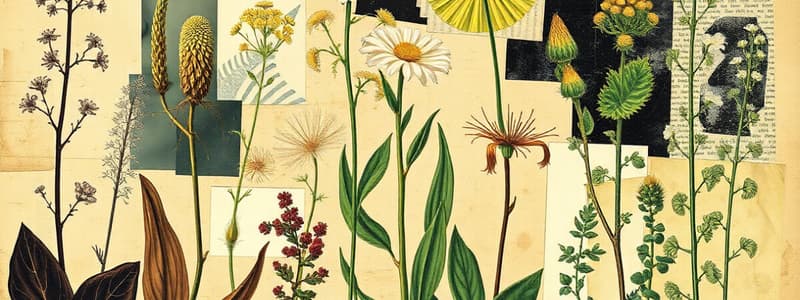Podcast
Questions and Answers
What is one primary function of dermal tissue in stems?
What is one primary function of dermal tissue in stems?
- Transport nutrients across the plant
- Protect the outer surface of the stem (correct)
- Store water and carbohydrates
- Provide structural support
Which characteristic distinguishes woody stems from herbaceous stems?
Which characteristic distinguishes woody stems from herbaceous stems?
- Herbaceous stems contain more water
- Woody stems increase in diameter each year (correct)
- Herbaceous stems have greater structural support
- Woody stems are primarily found in annual plants
What is the role of stomata in leaves?
What is the role of stomata in leaves?
- Support the structure of the leaf
- Capture sunlight for photosynthesis
- Allow for gas exchange (correct)
- Store water and nutrients
What happens when stomata close?
What happens when stomata close?
Which method is NOT a way that water moves up a plant stem?
Which method is NOT a way that water moves up a plant stem?
What initiates primary succession?
What initiates primary succession?
Which statement accurately describes secondary succession?
Which statement accurately describes secondary succession?
What is the primary function of vascular tissue in stems?
What is the primary function of vascular tissue in stems?
Which type of plant is characterized by having naked seeds?
Which type of plant is characterized by having naked seeds?
What type of vascular tissue primarily transports water in plants?
What type of vascular tissue primarily transports water in plants?
Which characteristic is typical of monocots?
Which characteristic is typical of monocots?
Which of the following is NOT a function of roots in plants?
Which of the following is NOT a function of roots in plants?
What distinguishes dicots from monocots in terms of root structure?
What distinguishes dicots from monocots in terms of root structure?
Which plant tissue is primarily involved in the production of Xylem and Phloem cells?
Which plant tissue is primarily involved in the production of Xylem and Phloem cells?
What is the main function of the epidermis in root structure?
What is the main function of the epidermis in root structure?
Which statement correctly describes the differences in vascular tissue between monocots and dicots?
Which statement correctly describes the differences in vascular tissue between monocots and dicots?
Study Notes
Plant Classification
- Three Classifications of Reproductive Plants:
- Bryophyta: Amphibious plants like moss, reproduce with flagellated sperm
- Gymnosperm: Naked seeds, includes all conifers like pine
- Angiosperm: Seeds enclosed within an ovary, includes flowering plants
Plant Divisions
-
Non-vascular Plants (Bryophytes):
- Limited by lack of vascular tissue
- Reproduce with flagellated sperm
- Rely on diffusion for nutrient transport
- Thrive in moist environments
-
Vascular Plants (Tracheophytes):
- Possess vascular tissue (tubes) for transporting food, water, and minerals
- Resistant to drying out
- Differentiated structures like roots, stems, and leaves
Angiosperm Types
-
Monocots:
- Pedals in multiples of three
- Long, slender leaves with parallel veins
- Randomly distributed vascular tissue in stem
- One cotyledon (seed leaf)
-
Dicots:
- Pedals in multiples of four or five
- Wide leaves with branching veins
- Circular arrangement of vascular tissue in stem
- Two cotyledons.
Plant Tissues
- Three types of plant tissues: roots, stems, leaves
- Conduction Tissue:
- Xylem: Transports water unidirectionally
- Phloem: Transports food (sugars)
- Cambium: Produces new xylem and phloem cells
Root Function
- Absorption of nutrients
- Stability and grounding
- Production of compounds (e.g., hormones)
Root Structure
- Primary Root: Originates from the seed
- Secondary Root: Derived from the primary root, smaller in size
Root Types
- Taproot: Found in dicots, long, thick, grows downward
- Fibrous Root: Found in monocots, no main root, many thin roots
Root Parts
- Meristems: Actively growing region, high mitotic activity
- Root Cap: Protects the meristems during growth
- Epidermis: Outer layer, contains root hairs for nutrient absorption
Stem Function
- Defense system
- Storage of water and carbohydrates
- Nutrient transport
- Stabilization and support
Stem Tissues
- Dermal Tissue: Outer surface of the stem
- Ground Tissue: Parenchyma cells surrounding vascular tissue
- Vascular Tissue: Transportation and structural support
Stem Types
- Herbaceous: Soft, green stem, little to no wood
- Woody: Increased diameter each year, found in perennial plants
- Perennial: Lasts many years
- Annual: Lasts one season
Leaf Function
- Photosynthesis
- Gas exchange (oxygen and carbon dioxide)
Leaf Parts
- Blade: Flattened section, positioned along nodes
- Petiole: Stalk connecting the blade to the stem
- Epidermis: Covered by a cuticle to prevent water loss
Stomata
- Location: Located on the underside of leaves, in pairs
- Function: Regulates gas exchange, protects the plant
- Guard Cells: Contain chloroplasts, regulate stomata opening and closing
Stomata Function
- Open: Gas exchange through diffusion (CO2 in, O2 out)
- Closed: Preserves water, often at night
Water Movement in Plants
- Three methods:
- Root Pressure: Hydrogen bonds draw water upwards
- Capillary Action: Adhesion, cohesion, and surface tension allow water to move up the cellulose walls
- Transpiration: Evaporation of water from leaves pulls water upwards in an unbroken chain
Succession
- Gradual change in species composition over time
- Primary Succession: Begins in an area with no soil or living organisms
- Secondary Succession: Occurs in areas disturbed by disasters or human activities (e.g., forest fires, clear cutting)
Studying That Suits You
Use AI to generate personalized quizzes and flashcards to suit your learning preferences.
Description
Explore the fascinating world of plant classifications, including Bryophyta, Gymnosperms, and Angiosperms. This quiz will help you understand the differences between non-vascular and vascular plants, as well as the characteristics that define monocots and dicots.




